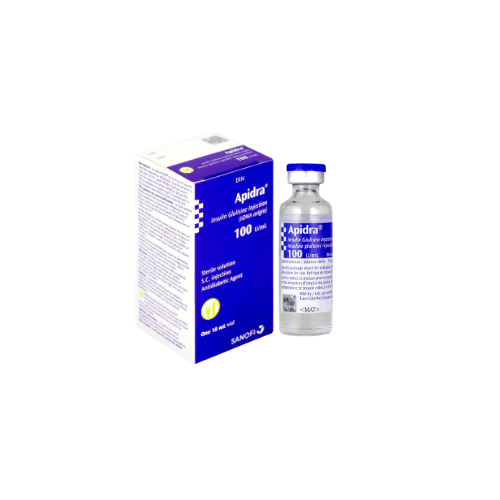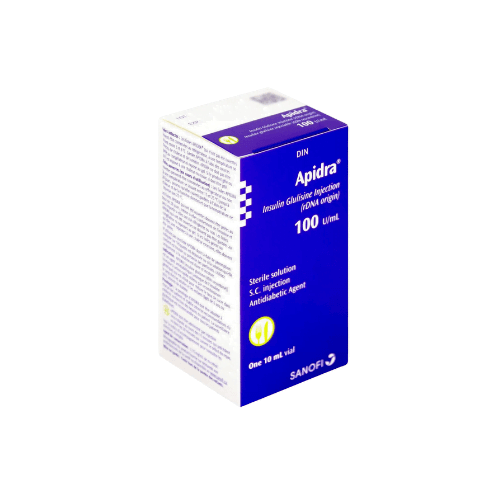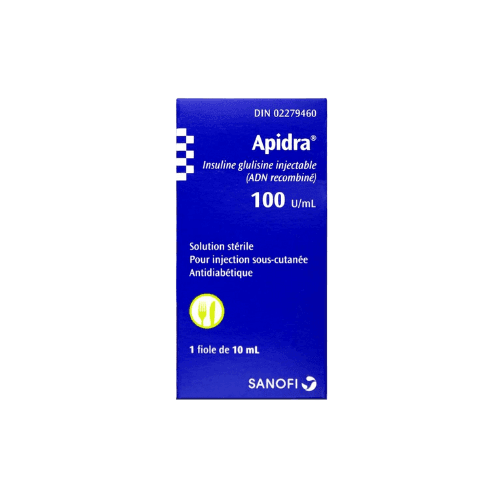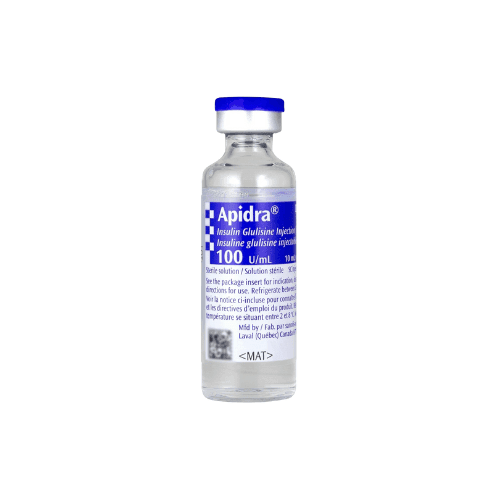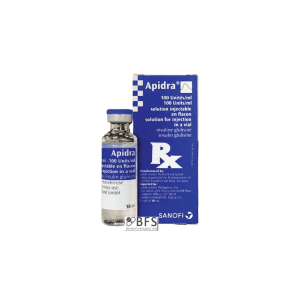Shipping with this method takes 3-5 days
Apidra® Vials for Type 1 and Type 2 Diabetes
$62.99
Secure Encrypted Payments
Apidra® is a rapid-acting insulin used to manage blood sugar around meals. It helps reduce post-meal spikes when used as part of a basal-bolus plan. We offer US delivery from Canada and clear information for those paying without insurance.
This page explains what it is, who it suits, and how to use and store it safely. You can review common effects, cautions, and practical tips before you order.
What Apidra Is and How It Works
Apidra® contains insulin glulisine, a fast-acting mealtime insulin. It starts working quickly to lower glucose after you begin eating. It is typically paired with a long-acting insulin for background coverage. In pump users, it may be used for continuous subcutaneous infusion as directed by a prescriber.
YouDrugstore is a licensed Canadian pharmacy in Manitoba. Pharmacists review prescriptions before dispensing.
This medicine works by helping glucose move from the bloodstream into muscle and fat cells. Onset and duration can vary by dose, site, and individual factors. Always follow your prescriber’s instructions and the official label.
Learn more about the condition it treats in our resources for Type 1 Diabetes and Type 2 Diabetes. For background therapy information, see Diabetes Care.
Who It’s For
This treatment is used in adults and in children when a mealtime insulin is indicated. It may be prescribed for type 1 diabetes as part of a basal-bolus plan, and for type 2 diabetes when rapid-acting insulin is needed to control meals.
Do not use if you have a known hypersensitivity to insulin glulisine or formulation components. Your clinician may avoid this medicine if you have frequent severe hypoglycemia or are unable to safely monitor your glucose.
Dosage and Usage
Use this mealtime insulin as instructed by your prescriber. It is generally injected subcutaneously within minutes before a meal or soon after the meal begins. Typical rotation sites include the abdomen, thigh, or upper arm. Rotate sites to reduce skin changes.
The dose is individualized. Your clinician may pair it with a background insulin. If you use a pump, follow device-specific guidance from your care team. Do not share needles, syringes, or vials.
Only mix with NPH insulin if your clinician advises, and inject immediately after drawing up. Do not mix for pump use. If your plan includes a long-acting insulin, your prescriber may discuss options such as Lantus Cartridges. This is an Apidra multidose vial, so use a new sterile syringe and needle for each injection.
For general technique support, see our step-by-step injection guide: Inject Mounjaro Guide.
Strengths and Forms
Common presentations include an Insulin glulisine 100 units/mL vial in 10 mL size for multiple doses. Pens and cartridges exist in other formats, but availability varies by region and stock. Your prescriber will determine the most appropriate device for your regimen.
If you prefer a pen-based option for bolus dosing, compare with cartridges or pens in our Diabetes Care category.
Missed Dose and Timing
If you forget a mealtime dose, check your blood glucose. Take the next planned dose at the next meal as directed by your prescriber. Avoid stacking extra units without clinical guidance, as this can increase the risk of hypoglycemia. If you are uncertain, consult the official label or your healthcare professional.
Storage and Travel Basics
Store unopened vials in the refrigerator as directed on the label. Do not freeze. Protect from excessive heat and direct light. Once in use, a vial may be kept at room temperature for the labeled in-use period. Keep out of reach of children and do not use if the solution looks cloudy, thickened, or colored.
When traveling, keep your supplies in hand baggage. Carry your prescription and a list of medicines. Use a protective case for vials and syringes. Do not leave insulin in a hot car or on ice. Bring backup needles, alcohol swabs, and a small sharps container if possible.
For broader self-care information, see our articles on Metformin Role and Reverse Prediabetes.
Pen Handling and Sharps Disposal
These vials are used with insulin syringes. Use a new sterile syringe and needle for every injection. After use, place needles and syringes directly into an approved sharps container. Do not recap needles by hand. Follow local guidance for disposal.
If you and your clinician prefer pens, see alternatives discussed below. For device education and awareness, you may also explore Diabetes Month 2025.
Benefits
This therapy offers flexible timing around meals within label guidance. It can be integrated with a long-acting background insulin as part of a comprehensive plan. The vial format allows precise dosing with syringes, which some people prefer for fine titration.
Side Effects and Safety
- Low blood sugar symptoms such as shakiness, sweating, or dizziness
- Injection site reactions like redness or mild swelling
- Skin changes at injection sites with repeated use
- Weight changes or fluid retention
Severe hypoglycemia, severe allergic reactions, and significant potassium changes are rare but can occur. The risk of low blood sugar can increase when used with other glucose-lowering agents. Seek medical attention if you experience severe reactions. Always review the Medication Guide and follow the official label.
Drug Interactions and Cautions
Medicines that lower glucose, such as sulfonylureas, may increase hypoglycemia risk when used together. Thiazolidinediones may promote fluid retention when combined with insulin. Beta-blockers can mask low blood sugar symptoms. Certain steroids, diuretics, and decongestants may raise glucose. Discuss all medicines, supplements, and illnesses with your prescriber.
Use caution in kidney or liver impairment. This insulin is not intended to self-manage diabetic ketoacidosis outside medical care. If you use a pump, follow pump-specific instructions and do not mix insulins in the reservoir.
What to Expect Over Time
With consistent use, many people see improved post-meal readings as part of a structured plan. Your prescriber may adjust dosing based on logs, meter data, or CGM trends. Expect some day-to-day variability. Plan for regular follow-ups to review your targets, carbohydrate intake, and hypoglycemia prevention steps.
Consider keeping a written log for meals, dose amounts, and activity. Use reminders to support timing with food. Reinforce daily routines that match your clinician’s plan.
Compare With Alternatives
Other rapid-acting insulins may be considered if your prescriber recommends a switch. Options include insulin lispro in Humalog Junior Kwikpen and insulin aspart in the Novorapid Cartridge. Your clinician will decide based on your needs, device preference, and glucose patterns.
Pricing and Access
Review current pricing on this page and compare plans with your prescriber. To explore potential savings, you can Buy Apidra Vials here and evaluate your options. Many customers research Apidra vial cost and overall therapy expenses before refills. We provide transparent Canadian pricing with US delivery from Canada.
If you are looking for promotions, see our current offers on Promotions. For additional learning, read our guides on Mounjaro Dosing Guide and Mounjaro Side Effects.
Availability and Substitutions
Supply can vary. If the vial size or format you need is unavailable, your prescriber may recommend a comparable rapid-acting insulin or a different device presentation. For continuity of care, consider planning your Apidra vial refill ahead of time so your therapy remains consistent.
Patient Suitability and Cost-Saving Tips
This medicine suits people who need rapid-acting insulin with meals and who can monitor glucose regularly. It may not be suitable if you have frequent severe lows or cannot safely use injection devices. Children should use it under pediatric guidance.
To manage costs, consider multi-month fills when appropriate, and schedule refills to avoid urgent trips. Store vials correctly to prevent waste. Discuss therapeutic alternatives and goals at each visit, and review your insurance or self-pay options periodically for the best fit.
Questions to Ask Your Clinician
- How should I time each dose in relation to my meals?
- What signs of low blood sugar should I act on first?
- Can I use this insulin with my current pump or should I inject?
- Is mixing with NPH appropriate for my plan?
- What is the recommended in-use period for an opened vial?
- How should I adjust for travel, time zones, or missed meals?
- Which long-acting insulin pairs best with my current regimen?
Authoritative Sources
FDA DailyMedSanofi Product ResourcesHealth Canada Drug Product Database
Ready to proceed? Order from YouDrugstore with prompt, express shipping with temperature-controlled handling when required. This information is educational and not a substitute for professional medical advice.
Express Shipping - from $25.00
Prices:
- Dry-Packed Products $25.00
- Cold-Packed Products $35.00
Shipping Countries:
- United States (all contiguous states**)
- Worldwide (excludes some countries***)
Standard Shipping - $15.00
Shipping with this method takes 5-10 days
Prices:
- Dry-Packed Products $15.00
- Not available for Cold-Packed products
Shipping Countries:
- United States (all contiguous states**)
- Worldwide (excludes some countries***)
How does this mealtime insulin differ from long-acting options?
This rapid-acting insulin is designed to control blood glucose around meals. It starts working quickly and has a shorter duration than background insulins. Long-acting agents provide steady basal coverage over many hours and are not intended for meal spikes. Your prescriber may combine both types to mimic physiologic patterns. The exact onset, peak, and duration can vary by dose, site, and individual response, so follow the official label and your clinician’s plan.
Can it be used in an insulin pump?
Insulin glulisine may be used for continuous subcutaneous infusion when your prescriber approves and you have device training. Follow pump manufacturer instructions and your diabetes care team’s guidance. Do not mix insulins in the reservoir. If unexpected highs or delivery alarms occur, check the infusion set, reservoir, and insulin appearance, and follow pump troubleshooting steps from your care team.
What should I know about mixing with other insulins?
Mixing rules are specific. If your clinician instructs you to mix with NPH for syringe injections, draw up the rapid-acting insulin first and inject immediately. Do not mix with other insulin types, and do not mix for pump use. If you are uncertain whether mixing is appropriate for you, consult the official label or your prescriber before attempting.
How should I store an opened vial?
Follow the label for in-use storage. An opened vial is typically kept at room temperature for the labeled period and protected from heat and direct light. Do not refrigerate needles or syringes. Discard if the solution becomes cloudy, discolored, or contains particles. Keep all supplies out of reach of children and never use past the expiration date printed on the carton or vial.
What if I miss a mealtime dose?
Check your blood glucose. If the meal has passed, do not take an extra unscheduled dose unless your care team instructs otherwise. Resume your normal plan at the next meal. Taking additional doses without guidance can raise the risk of low blood sugar. Keep fast-acting carbohydrates with you, and contact your healthcare professional if you are unsure how to proceed.
Is it appropriate for children?
Rapid-acting insulins are used in pediatric care when indicated, with dosing and supervision tailored by a pediatric specialist. Device choice, injection sites, and dose timing may be adjusted for age and activity. Caregivers should be trained in recognizing and treating hypoglycemia and in proper syringe handling and sharps disposal. Always rely on the official label and your clinician’s instructions.
Can other medicines affect how it works?
Yes. Some medicines can raise or lower blood glucose or mask low-sugar symptoms. Agents like sulfonylureas can increase hypoglycemia risk when combined with insulin. Thiazolidinediones may cause fluid retention when used together. Beta-blockers may hide typical warning signs of lows. Provide a full list of medicines and supplements to your prescriber so they can review interactions and precautions.
